Last updated on February 23rd, 2025 at 08:36 am
Discover how to set family boundaries for balanced dynamics to nurture individual growth while strengthening family unity.
Family is undoubtedly one of the most significant aspects of our lives.
It serves as the foundation for emotional support, security, and personal growth.
To maintain harmonious relationships within the family, establishing healthy boundaries is the way to go.
Family boundaries, when defined and respected, create an environment where communication thrives, individuality is honoured, and conflicts are minimized.
In this article, we have detailed everything you need to know from understanding family boundaries to setting and maintaining them for healthy family dynamics.
And we have done this in plain language for easy understanding.
Recommended: What are Personal Boundaries?
Table of Contents
- What are Family Boundaries?
- Why are Family Boundaries Important?
- Types of family boundaries
- Other Types of Family Boundaries
- Blended Family Boundaries
- Toxic, Unhealthy Family Boundaries
- Setting Family Boundaries
- Maintaining Healthy Family Boundaries
- Family Boundaries Quotes
- Frequently Asked Questions
- Final Word from The Conducts of Life
What are Family Boundaries?

Family boundaries are the guidelines, rules, and limits that define the interactions, behaviours, and expectations within a family unit.
These boundaries help establish a sense of order, safety, and respect among family members.
They can cover emotional, physical, and psychological aspects, clearly outlining individual autonomy while promoting healthy connections.
Clear family boundaries facilitate effective communication, mutual understanding, and the development of healthy relationships.
They also help prevent issues such as enmeshment or disengagement, encouraging an environment where each member’s needs, emotions, and identities are acknowledged and respected within the family structure.
Why are Family Boundaries Important?

Family boundaries are crucial for several reasons:
- Individual Autonomy: Boundaries allow each family member to have their own space, thoughts, and emotions, fostering independence and self-identity.
- Healthy Relationships: Clear boundaries promote respect, understanding, and empathy, leading to healthier and more fulfilling family relationships.
- Conflict Resolution: Well-defined boundaries help prevent misunderstandings and conflicts by establishing guidelines for communication and behaviour.
- Emotional Well-being: Boundaries protect individuals from emotional harm and provide a sense of security and stability within the family unit.
- Personal Growth: By respecting each other’s boundaries, family members can pursue personal growth and development without feeling stifled or constrained.
- Role Clarity: Boundaries help define roles and responsibilities within the family, reducing confusion and promoting a sense of order and structure.
Types of family boundaries

Family boundaries can be categorized into three types:
- Enmeshed
- Rigid, and
- Flexible
1. Diffuse or Enmeshed Family Boundaries
Enmeshed boundaries refer to a family dynamic where members lack autonomy and their identities become intertwined, blurring the lines between personal and family needs.
This can lead to a lack of individuality, emotional dependency, and difficulty establishing healthy relationships outside the family unit.
Enmeshed boundaries often result in overinvolvement in each other’s lives, making it challenging for family members to develop a sense of self.
This dynamic may hinder personal growth and autonomy, potentially leading to emotional stress and conflict.
Recognizing and addressing enmeshed boundaries is important for encouraging healthy independence and balanced family relationships.
Examples of Diffuse or Enmeshed Boundaries:
- Lack of personal space: Family members may have little privacy or personal space, leading to a sense of intrusion and overinvolvement in each other’s lives.
- Emotional dependency: Individuals may rely heavily on each other for emotional support, making it challenging to develop independence and self-reliance.
- Blurred roles: Family members may have unclear or overlapping roles, leading to a lack of individual identity and autonomy.
- Limited boundaries between generations: Parents may involve children in adult issues or fail to establish age-appropriate boundaries, blurring the lines between parental and child roles
Related: How to Set Physical Boundaries for Sanity
2. Family Rigid or Disengaged Boundaries
Family rigid boundaries are a dynamic where strict, inflexible rules and limitations govern interactions and relationships within the family unit.
This often leads to a lack of emotional expression, limited communication, and an absence of individual autonomy.
Family members may feel constrained and unable to express their needs or emotions freely.
While these boundaries can provide structure, they may also stifle personal growth and hinder the development of healthy, open relationships.
Addressing rigid boundaries involves encouraging flexibility, open communication, and mutual respect, allowing for individual expression and the nurturing of balanced family dynamics.
Examples of Family Rigid or Disengaged Boundaries:
- Emotional Distance: Family members may struggle to express emotions or provide support, leading to a lack of emotional connection and understanding.
- Strict Rules: There may be inflexible rules and limited negotiation, resulting in a lack of autonomy and individual expression.
- Lack of Communication: Family members may avoid open discussions or sharing personal thoughts and feelings, leading to a sense of isolation and misunderstanding.
- Limited Involvement: Family members may be emotionally distant and uninvolved in each other’s lives, leading to a lack of support and connection within the family unit.
Related: Tips on Setting Emotional Boundaries
3. Family Flexible Boundaries

Flexible boundaries in a family context involve a healthy balance between autonomy and connection.
They allow for open communication, emotional expression, and individual growth while maintaining a sense of togetherness.
Family members can freely express their needs and emotions, and there is room for negotiation and compromise.
This dynamic supports an environment where you feel supported and respected, leading to stronger, more harmonious family relationships.
It also promotes personal development within the family unit.
Examples of Family Flexible Boundaries:
- Open Communication: Family members engage in honest and respectful communication, allowing for the expression of thoughts, feelings, and needs without fear of judgment.
- Mutual Respect: Each family member respects the boundaries of others, understanding and accommodating individual differences and preferences.
- Negotiation and Compromise: Family members are willing to negotiate and find compromises that honor everyone’s needs and preferences.
- Supportive Autonomy: Individuals are encouraged to pursue personal growth and independence while feeling supported and connected within the family unit.
Related: How To Set Healthy Boundaries In A Romantic Relationship
Other Types of Family Boundaries

1. Physical Boundaries
These boundaries refer to the space within which family members feel comfortable and secure.
It includes personal space, individual rooms, and the physical separation between public and private areas of the home.
Physical boundaries help maintain privacy, autonomy, and respect among family members.
2. Emotional Boundaries
Emotional boundaries determine the level of emotional openness and intimacy within a family.
These boundaries define how feelings and emotions are shared, expressed, and respected.
Healthy emotional boundaries enable you to express your emotions freely while also respecting the emotional needs of other family members.
3. Intellectual Boundaries
Intellectual boundaries involve respecting each other’s thoughts, ideas, and opinions within the family unit.
It allows for open and respectful communication, where family members can freely express and share their intellectual perspectives without fear of ridicule or judgment.
4. Time Boundaries
Time boundaries refer to how family members manage and allocate their time individually and collectively.
Healthy time boundaries involve ensuring time for personal pursuits, work, leisure, and quality family time.
It helps promote a balanced lifestyle and prevents excessive demands or neglect of individual and family needs.
5. Role Boundaries
Role boundaries define the responsibilities, expectations, and tasks assigned to each family member within the household.
It helps in organizing and coordinating family functions, household chores, and decision-making processes.
Clear role boundaries ensure equality, fairness, and effective functioning within the family system.
6. Financial Boundaries
Financial boundaries relate to the management and distribution of financial resources within the family.
These boundaries help identify individual and collective financial goals, responsibilities, and limits.
Establishing and respecting financial boundaries entrenches transparency, accountability, and collaboration in financial matters.
7. Social Boundaries
Social boundaries involve the extent to which family members interact and engage with others outside the family unit.
It determines the level of involvement in social activities, friendships, and personal relationships.
Healthy social boundaries allow families to maintain a balance between their internal dynamics and external connections.
8. Cultural Boundaries
Cultural boundaries refer to the preservation and respect of cultural values, traditions, and practices within the family.
These boundaries help in maintaining cultural identity, language, and customs.
Respectful cultural boundaries create a sense of belonging, strengthen family ties, and promote diversity and inclusivity.
9. Generational Boundaries
Generational boundaries involve recognizing and respecting the differences between various generations within the family.
It acknowledges the unique experiences, perspectives, and needs of each generation.
Understanding and appreciating generational boundaries encourages intergenerational communication, cooperation, and empathy.
10. Personal Boundaries
Personal boundaries are your sense of self and personal autonomy within the family.
It involves setting limits and asserting your rights, preferences, and beliefs.
Healthy personal boundaries allow family members to define their identity, make choices, and protect themselves from physical or emotional harm.
Related: How To Create Healthy Sexual Boundaries With Your Spouse
Blended Family Boundaries
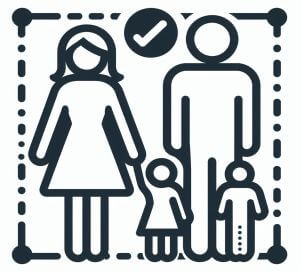
Blended family boundaries refer to the establishment of clear guidelines, rules, and expectations within a family unit that consists of biological parents, stepparents, stepchildren, and half-siblings.
These boundaries are essential for sustaining a harmonious and supportive environment, as they help navigate the complexities of different family dynamics, roles, and relationships.
Blended family boundaries involve considerations such as co-parenting arrangements, discipline strategies, communication protocols, and the integration of diverse family traditions and values.
By establishing and respecting these boundaries, blended families can promote understanding, respect, and unity while addressing the unique challenges that arise from combining multiple family structures.
Related: Understanding and Patching Porous Boundaries
Toxic, Unhealthy Family Boundaries
Unhealthy family boundaries manifest in various ways, such as enmeshment or disengagement as described above.
Enmeshed boundaries blur individual identities, leading to overinvolvement and emotional dependency, hindering personal growth.
Conversely, disengaged boundaries create emotional distance and lack of support, resulting in isolation and neglect.
These dynamics can lead to conflict, emotional stress, and hindered development of healthy relationships.
Unhealthy boundaries may also involve a lack of respect for personal space, emotions, and autonomy, contributing to a dysfunctional family environment.
Unhealthy and toxic family boundaries can manifest as follows:
- Enmeshment: when family members have blurred or boundaries of porosity, and there is little to no privacy or individuality.
- Control: when one or more family members try to manipulate or dictate the behavior or choices of others.
- Emotional neglect: when family members are emotionally distant, invalidating, or dismissive of each other’s needs, feelings, or thoughts.
- Physical or verbal abuse: when family members use harsh or violent means to express their frustration, anger, or disapproval.
- Codependency: when family members rely overly on each other for emotional support, validation, or identity, leading to an unhealthy and unbalanced dynamic.
These toxic boundaries in the family can lead to long-term emotional and psychological damage and can affect an individual even in adulthood.
Related: How To Set Healthy Boundaries
Setting Family Boundaries

1. Self-reflection
Begin by reflecting on your own needs, desires, limits, and values.
Understanding your boundaries will enable you to communicate them effectively to your family members.
2. Open Dialogue
Initiate an open and honest conversation with your family members about the importance of establishing boundaries.
Express your intentions clearly, making it known that boundaries are in place to strengthen the familial bond.
3. Define Boundaries
Collaboratively design family rules and agreements to create a shared understanding of everyone’s limits.
Ensure that these boundaries are fair, realistic, and adaptable over time.
4. Consistency and Accountability
Consistency is key when reinforcing family boundaries. Ensure that everyone respects and adheres to the agreed-upon boundaries.
Encourage open communication when boundaries are unintentionally breached and establish consequences if necessary.
5. Respect Privacy
Uphold the importance of privacy within the family.
Encourage personal time and respect each individual’s privacy by avoiding intrusive questions, snooping, or unnecessarily invading personal space.
6. Encourage Individuality
Encourage an environment that allows each family member to express their individuality.
Encourage personal hobbies, interests, and opinions, honoring the uniqueness of each person within the family.
Maintaining Healthy Family Boundaries
1. Regular Check-ins
Schedule regular family meetings to discuss and adjust boundaries as circumstances change.
This allows for flexibility while ensuring the family’s evolving needs are addressed.
2. Encourage Independence
Cultivate a sense of independence by promoting self-reliance and personal decision-making.
Encouraging responsibility empowers all family members to develop individual skills and become self-sufficient.
3. Seek Family Therapy
In cases where boundary issues persist or become challenging to navigate, consider seeking professional guidance.
Family therapy can provide effective tools and mediation techniques to resolve conflicts and strengthen family bonds.
Family Boundaries Quotes
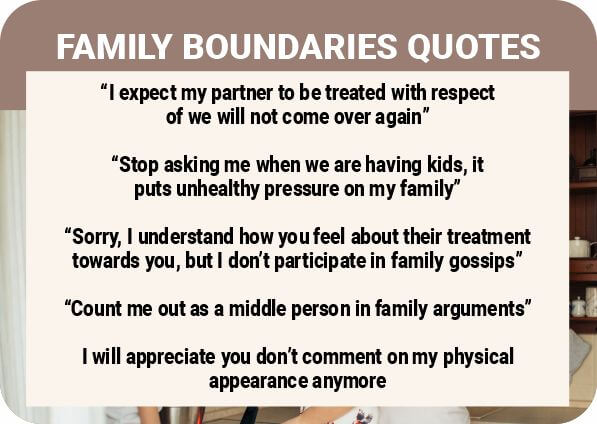
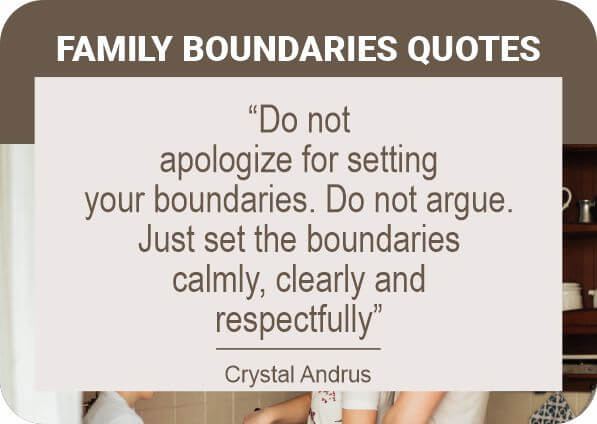
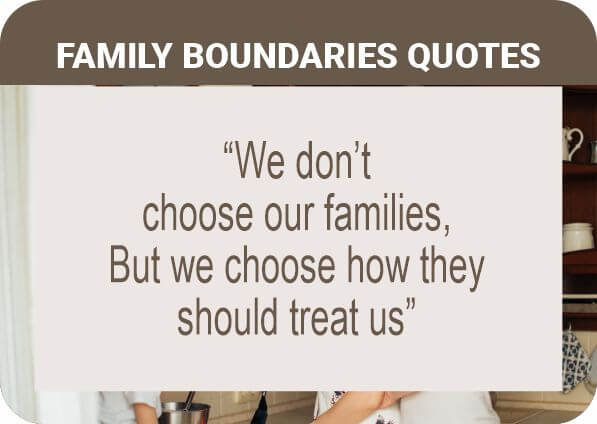
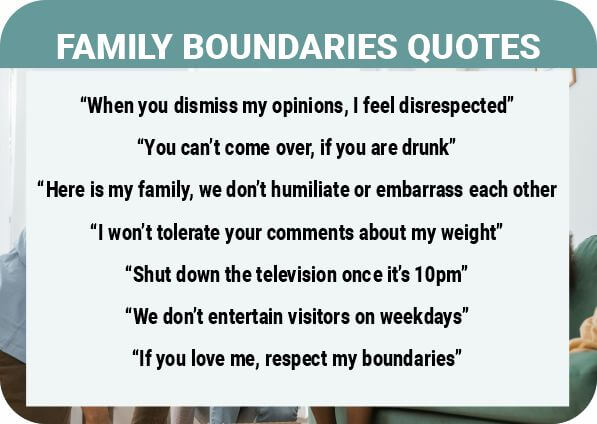
Frequently Asked Questions
How can we establish healthy family boundaries?
Establishing healthy boundaries in the family involves open communication, respect for individual needs, clear expectations, and mutual understanding and support within the family.
What are the consequences of unhealthy family boundaries?
Unhealthy boundaries in the family can lead to conflicts, emotional stress, hindered personal growth, dysfunctional family dynamics, and a lack of respect for personal space and autonomy.
How do family boundaries contribute to a harmonious family environment?
Boundaries in the family contribute to a harmonious environment by promoting respect, understanding, and healthy relationships, and providing security and stability within the family unit.
What role do family boundaries play in personal development?
Boundaries in the family play a crucial role in personal development by encouraging autonomy, healthy relationships, and emotional well-being, and providing a supportive and nurturing family environment.
Final Word from The Conducts of Life
Healthy family boundaries create an atmosphere of love, support, and understanding.
They promote individual growth, minimize conflicts, and improve communication within the family unit.
By establishing and maintaining boundaries, families can create an environment that appreciates personal autonomy, respects privacy, and values emotional well-being.
Embracing family boundaries is a transformative journey that leads to stronger bonds, personal development, and ultimately, a happier and more harmonious family life.
SOURCES:
- Setting Boundaries With Difficult Family Members
- Establishing Healthy Family Relationship Boundaries
- https://time.com/6331383/how-to-set-boundaries-family/
Pious Clements is the insightful voice behind "The Conducts of Life" blog, where he writes about life ethics, self-development, life mastery, and the dynamics of people and society.
With a profound understanding of human behaviuor and societal dynamics, Pious offers thought-provoking perspectives on ethical living and personal growth.
Through engaging narratives and astute observations, he inspires readers to navigate life's complexities with wisdom and integrity, encouraging a deeper understanding of the human experience and our place within society.
